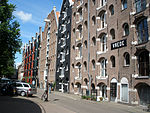Warehouses Medan, Bindjeij and Laboean
Apartment buildings in the NetherlandsBuildings and structures completed in 1900Buildings and structures in AmsterdamRijksmonuments in AmsterdamWarehouses in Amsterdam

As a continuation of the existing warehouses in the center of Amsterdam, around 1900 several new warehouses were built near the IJ bay. Most of these warehouses were converted into apartments at the end of 20th century.
Excerpt from the Wikipedia article Warehouses Medan, Bindjeij and Laboean (License: CC BY-SA 3.0, Authors, Images).Warehouses Medan, Bindjeij and Laboean
Nova Zemblastraat, Amsterdam
Geographical coordinates (GPS) Address Nearby Places Show on map
Geographical coordinates (GPS)
| Latitude | Longitude |
|---|---|
| N 52.390125 ° | E 4.884599 ° |
Address
Nova Zemblastraat 2
1013 RK Amsterdam
North Holland, Netherlands
Open on Google Maps











